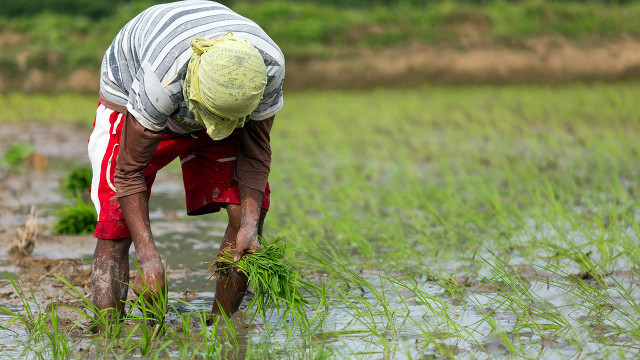SUMMARY
This is AI generated summarization, which may have errors. For context, always refer to the full article.

MANILA, Philippines (UPDATED) – Based on initial findings of the Department of Agriculture, Typhoon Glenda (Rammasun) inflicted P8.313 billion (US$192 million*) in damages to crops and fisheries, with Bicol and Quezon most affected.
A tally of the damages as of July 22 showed that rice suffered the most damage among crops at P988.5 million ($22.9 million). This is equivalent to 48,622 metric tons of palay. But of the total 50,999 hectares damaged, more than half or 33,595 hectares, may recover.
The second most damaged crop is corn with losses amounting to P988.1 million ($22.8 million). Of the affected 36,874 hectares, 23,034 hectares may yet recover.
Vegetables came in third with a production loss of P341.3 million ($7.9 million) with 2,190 hectares of damaged crop lands.
Damage to livestock reached P13.4 million ($310,000) while damage to agricultural infrastructure such as irrigation canals, post-harvest facilities, and fisheries infrastructure amounted to P517.1 million ($12 million). The typhoon destroyed many fish cages in Laguna de Bay, Taal in Batangas, and Rizal.
As for fisheries, the Bureau of Fisheries and Aquatic Resources (BFAR) reported P5.16 billion ($119.4 million) in total damages due to Glenda.
Coconut, one of the country’s top agricultural exports, suffered P4.61 million ($106,000) in damage. This is equivalent to more than 4,300 hectares of coconuts mostly in Quezon.
The report covered 15 provinces and 4 regions including Quezon, Occidental and Oriental Mindoro, Bicol in Luzon and Leyte, Southern Leyte, Biliran, Samar, Eastern Samar and Northern Samar in Visayas.
Prior to the DA’s tally, the National Disaster Risk Reduction and Management Council (NDRRMC) pegged typhoon damage to the agricultural sector at an initial P668,233,477.94 covering only Region V for rice, corn, high value crops, and livestock.
Effect on supply and prices
Based on the initial findings, it doesn’t look like the damage will significantly affect the country’s food supply, said Agriculture Secretary Proceso Alcala during a July 17 press conference.
“Every time we are hit by a storm, this is the time when we have buffer stocking. We have buffer stock in every region. After 5 to 7 days, the farmers will get back to their livelihood. By that time, we must be sure to have substitute crops to distribute to them if they were really hit,” he told reporters in a mix of Filipino and English.
He also said that most of the farmers only started planting because the rainy season began just recently. This means most of the affected crops are in their vegetative stage and are still likely to survive.
If a farmer’s palay or corn crop will not recover, the department will automatically distribute certified seeds to them for free. Municipal agriculturists and regional field officers already started yesterday, July 16, to validate the farmers affected.
The agency needs the certification of the municipal agriculturists before they can supply substitute seedlings to farmers.
Alcala also said that the agency will ask help from other less affected regions to boost supplies.
“Camarines Norte was not affected as badly. So we are asking the traders there if they can augment what Quezon cannot supply,” he said.
In fact, the typhoon may have been good for the agricultural sector in Northern Luzon since rains brought much-needed water to crops, said Alcala.
The department will also assist provinces like Nueva Vizcaya and Benguet that need help in transporting their crops to Metro Manila.
Price hikes in agri products?
With the limited information collected by the department, the effect of the typhoon’s damage will reflect in the prices of crop commodities only in the next few days.
But the DA does not observe any increase in the price of vegetables, the second hardest-hit crop, at least in Metro Manila, said Dax Gazmin, Director of the department’s Agribusiness and Marketing Assistance Service (AMAS). They will closely monitor prices in the coming days.
He added that prices are likely to be stable since sellers still have their supplies of crops before the typhoon came.
Another way to keep price hikes at bay is to coordinate with the Department of Trade and Industry (DTI) to put a suggested retail price for affected crops in affected areas, said Alcala.
The agency is also working with the National Price Coordinating Council.
“What’s important is the department informs everyone that there is enough supply. So we are monitoring the deliveries. If there is a price increase, we will immediately check if there is really a good reason for the increase,” said Gazmin.
Alcala also gave assurances that the DA is ready for the next storm, which may happen in a few days’ time, according to state weather bureau PAGASA.
“What’s good now is PAGASA is able to give very accurate forecasts. Before this typhoon came, 3 days before, we called the regional directors of the regions predicted to be affected. Many regions quickly harvested their crops with the use of combine harvester.”
A combine harvester, a machine that reaps and threshes grain in one go, allows farmers to harvest faster. Because of this machine, farmers were able to quickly harvest their crops before the typhoon hit. The DA will validate the exact amount of crops that were saved. (READ: Machines on PH farms: Catching up with ASEAN integration)
Alcala also said the DA is working on the even distribution of the types of crops planted all over the country. This allows other regions to supply all kinds of crops when other regions are affected by an extreme weather event. – Rappler.com
*$1 = P43.6
Get the latest update on #GlendaPH via our live blog.
Help map latest information and critical alerts through #GlendaPH: Map latest info and critical alerts.
Visit Project Agos for the latest stories on areas affected by Typhoon Glenda.
Filipino farmer image via Shutterstock
Add a comment
How does this make you feel?
There are no comments yet. Add your comment to start the conversation.